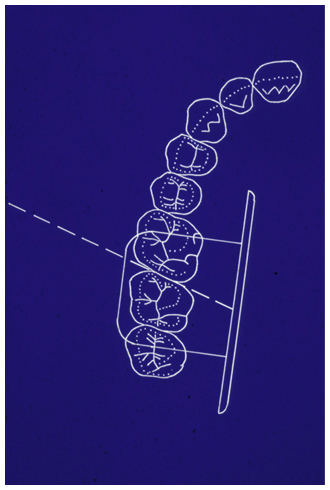What is horizontal angle?
Horizontal angle refers to the position the Position Indicating Device (PID or cone) is along the axial plane. Horizontal angle can be increased or decreased. A zero degree horizontal angle is when the PID is positioned parallel with the sagittal plane. Increasing horizontal angle moves it towards and parallel with the coronal plane. Decreasing horizontal angle moves it toward and parallel with the sagittal plane. Below are images with a very cooperative patient (Bob, as I like to refer to him as) demonstrating this.
 Above: Horizontal angle along the axial plane.
Above: Horizontal angle along the axial plane.
Above: Horizontal angle increases as it moves parallel with the coronal plane.
Horizontal angle decreases as it moves parallel with the sagittal plane.
Common errors due to incorrect horizontal angle
Errors due to incorrect horizontal angle manifest as overlapping of crowns and roots of adjacent teeth. This is very important when making bitewing radiographs in your office. If the horizontal angle is not parallel with the contact you are wanting to see, you will get overlap. At the school, we aim for one primary contact on each bitewing radiograph. On a molar bitewing radiograph, we aim the horizontal angle such that is parallel with the contact between the maxillary first and second molars. The diagram below shows this.
For a premolar bitewing radiograph, we aim the horizontal angle such that it is parallel with the contact between the maxillary first molar and second premolar. The reason we use the maxillary molars and not the mandibular molars is due to their shape. Maxillary molars have a rhomboidal shape. The more square the shape, the less forgiving the contacts with horizontal angle. Below are two premolar bitewing radiographs. The first one (left) is when the horizontal angle is parallel with the contact between the maxillary first molar and second molar. Note no overlap between the maxillary first molar and second premolar. The second one (right) is when the horizontal angle was not parallel with the contact between the maxillary first molar and second molar. Note the overlap of the crowns making detection of interproximal decay difficult if not impossible when severe overlap is present.
Click image to enlarge
How to ‘see’ horizontal angle
When teaching students how to position the PID with the correct horizontal angle for bitewing radiographs, we require them to work their legs. We will have a patient (DXTTR initially) open and then squat down and look up at the maxillary occlusion to visualize how the teeth contact each other. Every student will initially learn by doing squats in the clinic (a great way to get your leg workout in for the day 🙂 ). Many students continue to use this method til they graduate and into private practice. Some are able to visualize the contacts after time in the clinic without doing squats. If you’ve never tried this technique before. Give it a shot to see how you should position the PID to open contacts on your bitewing radiographs.
I hope this brief introduction to horizontal angle is helpful in your practice or as a refresher. Please let me know if you have questions.
Thanks and enjoy!





3 thoughts on “Radiographic Technique: Horizontal Angle”
Comments are closed.